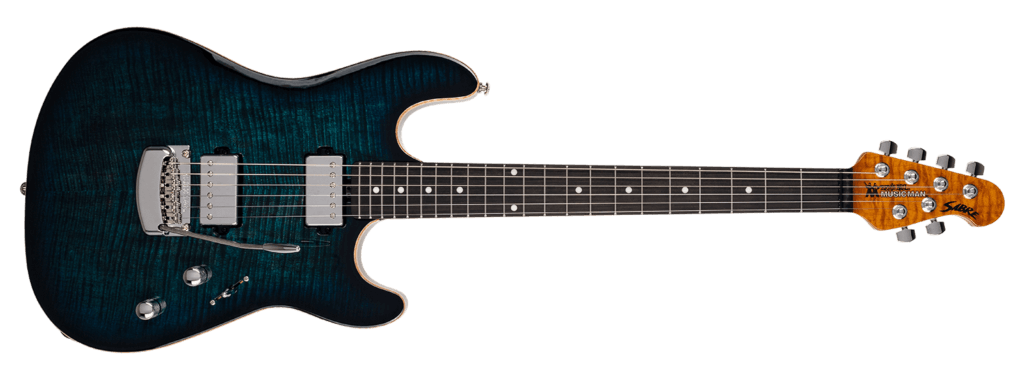
Typically, when a manufacturer offers up a lower-priced import instrument, it’s been streamlined for costs; components are often inexpensive, electronics are simpler, and design features found in higher end models are skipped over. Ernie Ball Music Man took their Sabre guitar, and made a Sterling version that maintains higher-end features and components
With a nyatoh body (a hardwood found in Southeast Asia, sometimes referred to as ‘nato’) and a flame maple veneer, the blue burst high gloss finish is quite striking. The back is a very dark blue stain as well, that really pops under sunlight, and highlights a very nice grain pattern. It’s paired to a roasted maple neck with a truss rod wheel at the butt of the neck and is easily accessible for any possible adjustments needed. A very ergonomic 5-bolt neck joint that offers up an amazing access to the upper areas of the fingerboard, and is usually not seen in an import instrument.
Speaking of fingerboards, it’s rosewood with 22 stainless steel frets and has a 25 ½” scale length. The fretwork was excellent, and the modern C shape neck has some girth to it with a 12 inch radius, while the 4+2 headstock has locking tuners fitted. At the other end, you’ve got a modern two-post tremolo with a pop-in arm, and nicely milled solid saddles. The pickups are modern Fishman Fluence active humbuckers, directly mounted into the body, with a volume, tone and three way blade switch. For added tones, the controls are push pulls, with the volume control a coil tap for single coil mode, and the tone control engages the second voicing of the pickups.
Right out of the box our test instrument was nicely set up with a set of .10 strings, and played beautifully. The neck has a silky smooth feel, and the fretwork was phenomenal. For players who haven’t experienced stainless steel frets, this may ruin you for other instruments, as the feel of this neck was phenomenal overall. While the bridge isn’t the same one found on its USA siblings, there’s no issues to be had. The body is a somewhat traditional S-type, but the contours are modern, sleek and still very comfortable.
The Fishman pickups are a great pairing to this guitar, with a modern feel overall, and a tight and very focused response. They still feel natural though, but seem to have weeded out any inconsistencies of traditional pickups for a more balanced response. The big test it passed was that the bridge pickup in a clean setting wasn’t spiky or harsh — it sounded full, bright and punchy, while the neck pickup had the warmth and bottom end without any flabbiness. Pulling up on the volume engaged the coil split mode, which doesn’t react like typical passive coil taps. There was no loss of unity gain, and didn’t totally change the sound; the result was more like a pass filter, rolling off bass response, and added in a smoother feel. It won’t out spank a Tele or replace a Strat, but it offers up a bit more clarity. The second voicing is engaged by pulling up on the tone control, and has a warmer sound in comparison.
Running this through a variety of amps, simulators, and plug-ins, the overall sounds certainly favor a modern touch, think of it as High-definition guitar. The active pickups certainly run the show, but the playability adds to the modern response. Drive tones are amazing, and this guitar is meant for modern players, but it’s not that far away from familiarity. There was never a moment where it left our tester high and dry trying to pull something off, or wanting a more natural or vintage flavour. It stays in its lane, but it can cover a lot of territory for one instrument. The coil split mode wasn’t as present as it may be on other instruments, but when it was engaged, it didn’t need any EQ or volume adjustments to compensate for the shift in the sound.
At no point while playing this instrument did the thought “this is an import instrument” pop into our heads. It had the feel, sound and response of an amazingly well sorted guitar. This certainly re-sets the bar on what you may think of import guitars.
In all that audio and playing perfection, our test guitar had an issue: the finish. A thin unfinished strip that mimics a natural binding separates the top and sides, and along the top edge for about 80% of the instrument there was a lot of blue bleeding into that natural edging from the top side.
It appears that the masking process wasn’t done properly in the finishing process. There was also a small area of the edging in the upper cutaway that was discolored, and appeared to be a grain filler. This was a bummer for sure, as the rest of this instrument was executed so well. In. many cases, Sterling instruments are sold on-line through non brick and mortar stores, and these retailers are reputable, and have very good return policies. A player that gets an instrument with an issue such as we encountered should have no problem getting sorted out. Did it affect playability? Absolutely not. And of course, your level of obsessiveness when it comes to cosmetics may vary 🙂
It’s certainly the import instrument that doesn’t need ANYTHING done to it in terms of feel or sound. It’s pro level across the board. The street price certainly reflects the upgrades such as the pickups, roasted maple neck and stainless steel frets, and if our test guitar didn’t have the finish issues this would be a five out of five stars in our book.
PROS:
Excellent playability, fantastic pickups
CONS:
Slight finish issues on our test guitar. Probably not an issue in the real world.
STREET PRICE:
$1499
